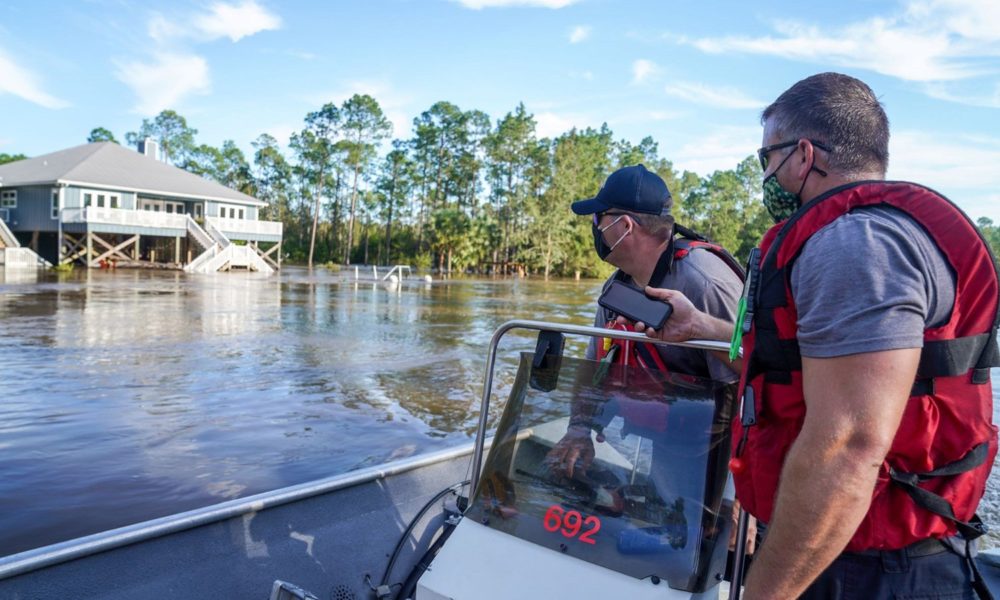Update 12/9/20: This post has been updated to accurately portray legislative and administrative authorities and the National Public Infrastructure PDM fund.
After a year of record-setting disasters during the pandemic, it’s clear that communities need public and technical assistance to help them better prepare for, respond to, and recover from hurricanes, flooding, wildfires, among other disasters. Out of the gate, President-elect Biden can bolster community resilience by amplifying FEMA’s “Building Resilient Infrastructure and Communities (BRIC)”.
FEMA’s BRIC program was a hard-fought win to create a new way to provide pre-disaster mitigation (PDM) assistance to communities. In 2018, Congress established the BRIC program with the bipartisan passage of the Disaster Recovery Reform Act (DRRA). Specifically, the law allows the President to set aside six percent of the estimated expenses from each major disaster and move these funds into the new National Public Infrastructure PDM fund, to help states, local communities, tribes and territories implement a range of PDM activities and ensure they are better prepared before the next disaster strikes and thus better able to reduce the costs of damages. This was a substantial change because it meant for the first time, FEMA would have a consistent and larger funding allocation for pre-disaster mitigation.
According to FEMA, six percent of the disaster funds allocated to federally-declared disasters this year, which include the COVID-19 pandemic and other recent climate and weather-related disasters, would result in a set-aside of roughly $3.7 billion. However, FEMA has only set aside $500 million for pre-disaster mitigation so far –a fraction of what is needed by communities on the ground. In the dawn of his presidency Mr. Biden can bolster community resilience by allocating full funding to FEMA’s BRIC program.
A year of record-breaking disasters
 Impacts from human induced climate change wreaked havoc in 2020 and science tells us the future will continue to bring such extremes this century and beyond. We experienced a whiplash of back-to-back extreme weather events associated with an unprecedented wildfire season, drought and heatwaves, inland flooding and a derecho in the Midwest and a record-breaking Atlantic hurricane season all happening alongside the pandemic which caused rises in unemployment and homelessness, and a hunger surge.
Impacts from human induced climate change wreaked havoc in 2020 and science tells us the future will continue to bring such extremes this century and beyond. We experienced a whiplash of back-to-back extreme weather events associated with an unprecedented wildfire season, drought and heatwaves, inland flooding and a derecho in the Midwest and a record-breaking Atlantic hurricane season all happening alongside the pandemic which caused rises in unemployment and homelessness, and a hunger surge.
But the ugly truth is that 2020 has been particularly unkind to the historically disadvantaged and vulnerable communities living in harm’s way.
- My colleague Juan Declect-Barreto’s analysis describes how particularly vulnerable populations are more exposed to COVID-19.
- My colleague Adrienne Hollis wrote about how a disproportionately high numbers of Black, Latinx and Indigenous people have lost their lives due to COVID-19.
- Many of these same communities that are disproportionately impacted by the pandemic were also impacted by the record inland flooding and the Atlantic hurricane and wildfire
While 2020 disasters have caused havoc and suffering nationwide, they’ve also been extremely costly. As of October 7, the US had experienced 16 weather- or climate change-related disasters with losses exceeding $1 billion, totaling roughly $50 billion. However – it’s important to note that these are preliminary numbers and NOAA has yet to tally and account for disaster events like Hurricane Sally, the historic Western wildfires and the Western/Central drought and heatwave, and this tally will need to be updated to account for the whole year.
To help blunt these compounding impacts, President-elect Biden can work to reduce heat trapping emissions, invest in building community resilience and target resources for historically disadvantaged and tribal communities.
How FEMA’s BRIC program helps make people and their communities more resilient

The BRIC program prioritizes funding for risk reduction projects in the following four areas:
- public infrastructure projects;
- projects that reduce risks to critical health, safety or economic security lifelines (such as hospitals and microgrids);
- natural infrastructure: this refers to risk reduction solutions like wetlands, oyster reefs and dunes that minimize impacts from inland and coastal flooding, erosion and runoff among other risk reduction services. In addition to the primary risk reduction benefit, natural infrastructure often provides multiple co-benefits such as the provision of habitat, recreational uses, and potential for carbon storage; and
- the implementation and enforcement of modern building codes.
FEMA has a valuable overview of these different types of risk reduction projects and planning in their Mitigation Action Portfolio report that includes a compilation of diverse case studies.
A portion of BRIC funds can also be utilized for direct technical assistance, management costs, capability and capacity building activities and mitigation planning including integrating hazard mitigation into existing planning efforts such as comprehensive plans, transportation plans, climate change and infrastructure plans, and floodplain ordinances.
The hazard risk reduction measures under these types of projects have proven to be particularly cost effective for the federal government to invest in – whether the threats be from inland flooding, coastal flooding, wind, earthquakes or wildfires.
As an example, FEMA recently issued a new report entitled, “Building Codes Save: A Nationwide Study: Losses Avoided as a Result of Adopting Hazard-Resistant Building Codes.” The study found that a shocking 65 percent of counties, cities, and towns across the US today have not yet adopted modern building codes (see map). FEMA estimated the amount of money that could be saved in property losses from disasters such as floods and hurricanes based on forecasting the use of modern building codes nationwide from 2000-2040 to be equivalent to $132 billion – that’s a big chunk of change to be throwing down the drain, not to mention the toll on communities from indirect costs such as lost income, business interruptions or homelessness.
The good news is that FEMA has calculated the additional cost of building code measures such as roof tie-downs, window protection, and strengthened walls and roof coverings, to be on average less than 2 percent of total construction costs. That minimal increase in building cost will pay dividends down the road with a multitude of benefits including lives saved, fewer injuries and less displacement, and taken as a whole, means a more viable and resilient community and less strain on FEMA resources.
 Three ways President-elect Biden can improve the BRIC program
Three ways President-elect Biden can improve the BRIC program
President-elect Biden has the opportunity to commit to investing in tried-and-true risk reduction measures to help communities prepare before the next disaster or extreme weather event. Here are three ways the new Biden Administration could work in concert with Congress to improve the BRIC program:
1) Protect and expand the BRIC funding by:
- working with Congress to make the six percent set-aside mandatory and even potentially increasing the percentage of the set-aside funding allocation;
- resisting any attempt to poach or repeal the funding allocation intended for communities to invest in pre-disaster mitigation projects; and
- increasing the set-asides for Tribes, low-income, and otherwise disadvantaged communities.
2) Task FEMA to report on:
- the degree to which COVID-19 hindered the ability of communities to successfully apply for BRIC funding by the January 29, 2021 deadline;
- the degree to which FEMA has improved the timeliness, efficiency, and the flexibility of the BRIC program and application process based on grantee satisfaction;
- the number of grantee applications and the degree to which the BRIC program is oversubscribed;
- whether disadvantaged and marginalized communities are benefitting equitably from the BRIC program; and
- whether the tribal set aside is sufficiently meeting tribal risk reduction needs.
3) Request that FEMA incorporate adaptive management into the BRIC program to be sure FEMA:
- conducts adaptive iterations of BRIC that include integrating grantee feedback and lessons learned with the goal of continually improving upon the BRIC priorities, efficiency and reporting; and
- consistently reviews how climate-smart and equitable the BRIC program is in practice.
President-elect Biden has a critical opportunity to prepare the nation for an increasingly risky future
After four years of the Trump Administration that will be remembered by many for turning its back on helping communities deal with the compound risks of the pandemic and climate change related impacts, the nation is ready for President-elect Biden to bring steadiness at the helm. The Biden Administration, in concert with Congress, can make substantial strides in helping communities prepare for the next extreme weather event by restoring and amplifying funding for FEMA’s BRIC program. This essential first step will help the Biden presidency hit the ground running when it comes to increasing community resilience and decreasing the toll and hardship of already strained families, all while saving taxpayer dollars in the long run.

